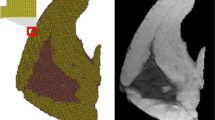Abstract
In this article, we present a novel approach to localize anatomical features—breast costal cartilage—in dynamic contrast-enhanced MRI using level sets. Current breast MRI diagnosis involves magnetic-resonance compatible needles for localization [12]. However, if the breast costal cartilage structure can be used as an alternative to the MR needle, this will not only assist in avoiding invasive procedures, but will also facilitate monitoring of the movement of breasts caused by cardiac and respiratory motion. This article represents a novel algorithm for achieving reliable detection and extraction of costal cartilage structures, which can be used for the analysis of motion artifacts, with possible shape variations of the structure caused by uptake of contrast agent, as well as a potential for the registration of breast. The algorithm represented in this article is to extract volume features from post-contrast MR images at three different time slices for the analysis of motion artifacts, and we validate the current algorithm according to the anatomic structure. This utilizes the level-set method [18] for the size selection of the region of interest. The variable shape of contours acquired from a level-set-based segment image actually determines the feature region of interest, which is used as a guide to achieve initial masks for feature extraction. Following this, the algorithm uses a K-means method for classification of the feature regions from other types of tissue and morphological operations with a choice of an appropriate structuring element to achieve reliable masks and extraction of features. The segments of features can be therefore obtained with the application of extracted masks for subsequent motion analysis of breast and for potential registration purposes.









Similar content being viewed by others
Explore related subjects
Discover the latest articles, news and stories from top researchers in related subjects.References
Antoine Maintz JB, Viergever MA (1992) A survey of medical image registration. Comput Surv 24(4):325–376
Chan TF, Vese LA (2001) Active contours without edges. IEEE Trans Image Process 10(2):266–277
Drake R, Vogl W, Mitchell A (2009) Gray’s Anatomy for Students, 2nd Ed. Elsevier, Australia
Frantz S, Rohr K, Stiehl HS (2005) Development and validation of a multi-step approach to improved detection of 3-D point landmarks in tomographic images. Image Vis Comput 23(11):956–971
Guo YJ, Sivaramakrishna R, Lu CC, Suri JS, Laxminarayan S (2006) Breast image registration techniques: a survey. Med Biol Eng Comput 44(1-2):15–26
Hayton P, Brady M, Tarassenko L, Moore N (1997) Analysis of dynamic MR breast images using a model of contrast enhancement. Med Image Anal 1(3):207–224
Hendrick RE (2008) Breast MRI. Fundamentals and technical aspects. Springer, New York
Jonasson L, Hagmann P, Pollo C, Bresson X, Wilson CR, Meuli R, Thiran JP (2007) A level set method for segmentation of the thalamus and its nuclei in DT-MRI. Signal Process 87(2):309–321
Lu WZ, Yao JH, Lu C, Prindiville S, Chow C (2006) DCE-MRI segmentation and motion correction based on active contour model and forward mapping. In: Seventh ACIS international conference on software engineering, artificial intelligence, networking, and parallel/distributed computing, vol 19–20, Las Vegas, pp 208–212
MacQueen JB (1967) Some methods for classification and analysis of multivariate observations. In: Proceedings of 5th Berkeley symposium on mathematical statistics and probability, University of California Press, Berkeley, pp 281–297
Malladi R, Sethian J, Vemuri B (1995) Shape modeling with front propagation: a level set approach. IEEE Trans Pattern Anal Mach Intell 17(2):158–175
Morris EA, Liberman L (2005) Breast MRI diagnosis and intervention. Springer, New York
Osher S, Sethian JA (1988) Fronts propagating with curvature-dependent speed: algorithms based on hamilton–jacobi formulations. J Comput Phys 79(1):12–49
Paragios N, Deriche R (2002) Geodesic active regions: a new framework to deal with frame partition problems in computer vision. J Vis Commun Image Represent 13(1-2):249–268
Serra J (1982) Image Analysis and Mathematical Morphology. Academic Press, London
Shechter G, Resar JR, McVeigh ER (2006) Displacement and velocity of the coronary arteries: cardiac and respiratory motion. IEEE Trans Med Imaging 25:369–375
Sinha S, Sinha U (2009) Recent advances in breast MRI and MRS. NMR Biomed 22(1):3–16
Zhang Y, Matuszewski BJ, Shark LK, Moore CJ (2008) Medical image segmentation using new hybrid level-set method. In: Proceeding of the fifth international conference on bioMedical visualization, Applied Digital Signal and Image Processing Research centre, pp 71–76
Zhukov L, Museth K, Breen D, Whitakery R, Barr AH (2003) Level set modeling and segmentation of DT-MRI brain data. J Electron Imaging 12(1):125–133
Acknowlegement
This study was supported in part by the Australian Research Council (ARC) Discovery Project funding scheme—Project No. DP0988064
Author information
Authors and Affiliations
Corresponding author
Rights and permissions
About this article
Cite this article
Yin, X.X., Ng, B.WH., Yang, Q. et al. Anatomical landmark localization in breast dynamic contrast-enhanced MR imaging. Med Biol Eng Comput 50, 91–101 (2012). https://doi.org/10.1007/s11517-011-0772-9
Received:
Accepted:
Published:
Issue Date:
DOI: https://doi.org/10.1007/s11517-011-0772-9




